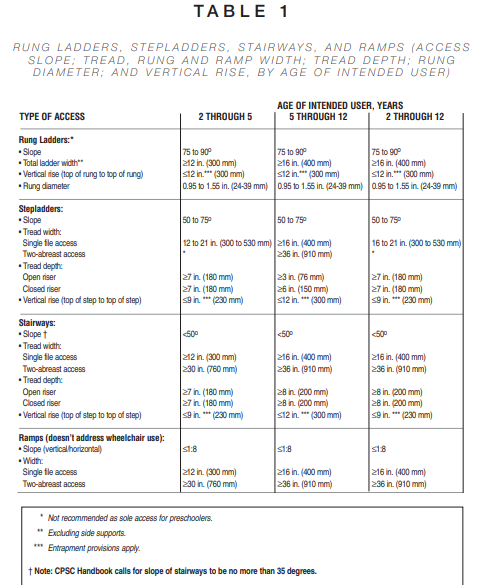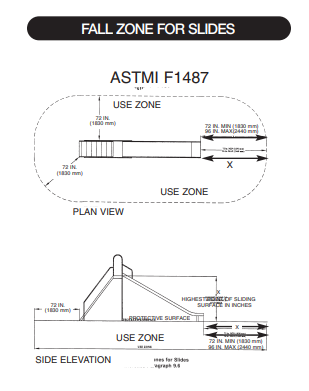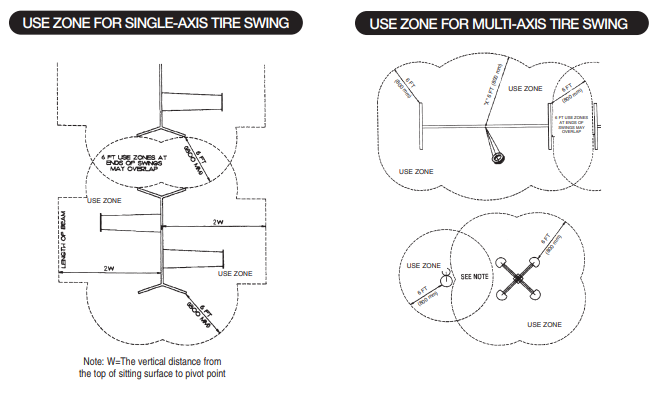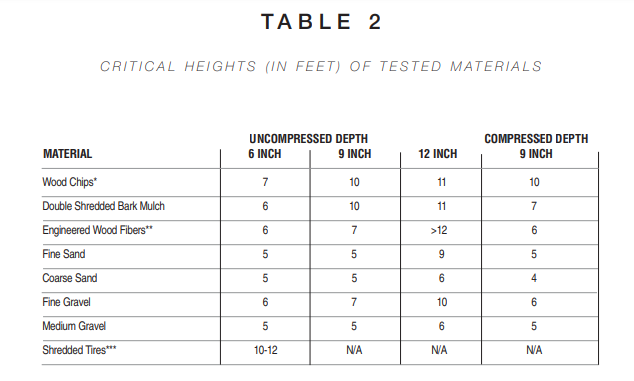Title Page
LOCATION OF PARK/PLAYGROUND
-
What park/playground is being inspected?
-
Date Inspected
Playground Inspector(s)
-
Inspected by
-
Inspected by
General Hazards
Sharp Points, Corners and Edges
-
• No sharp points, corners or edges on any component of playground<br>equipment.<br>• Wood parts to be smooth and no splinters.<br>• All corners, metal and wood, should be rounded. Minimum curvature<br>of 1/4 inch for corners and edges of suspended assemblies.<br>• Exit end and sides along a slide bed should have special attention.<br>• Exposed open ends of all tubing shall have caps or plugs that<br>cannot be removed without tools.
Protrusions and Projections
-
• No protrusion or projection allowed that is capable of entangling<br>children’s clothing or causing lacerations.<br>• Special attention required at the top of slides to minimize clothing<br>entanglement.<br>• All protrusions are to be tested in accordance with test procedures.<br>No protrusion should extend beyond the face of the gauge.<br>• Inaccessible protrusions exempted.<br>• Exposed bolt ends should not protrude more than two threads<br>beyond face of the nut, must be free of burrs and sharp edges.<br>• No projection shall increase in size or diameter from initial surface to<br>outer end even though it fits within gauges.<br>• A projection that extends upward from a horizontal plane is an<br>entanglement hazard.
Pinch, Crush and Shearing Points
-
• There are no accessible pinch, crush or shearing points on playground equipment.<br>• To determine if there is a possible pinch, crush or shear point, consider the likelihood of entrapping a body part.<br>• Must not entrap a 5/8 inch diameter rod. Opening less than 1 inch<br>acceptable if probe cannot touch any pinch, crush or shear point.<br>• Exemptions: Chain and its method of attachment; attachment area of<br>coil springs to body and base of rocking equipment.
Tripping Hazards
-
• All anchoring devices such as footings and horizontal bars at the bottom of flexible climbers, to be installed below playing surface.<br>• Special attention to be given to environmental obstacles such as<br>rocks, roots and other protrusions from the ground.<br>• Support posts for balance beams shall not pose a tripping hazard.<br>• Retaining walls should be highly visible; change of elevation should<br>be obvious. Bright colors add to visibility
Head and Torso Entrapment
-
• A component or group of components should not form openings that<br>could trap a child’s head or torso.<br>• The distance between any interior surface is to be less than 3-1/2<br>inches or greater than 9 inches.<br>• The above opening requirement applies to all openings if it penetrates 4 inches regardless of their height above the ground, except<br>where the ground serves as the opening’s lower boundary.<br>• Non-rigid openings considered accessible if torso probe penetrates<br>to a depth of 4 inches with a force of 50 lbs.
Angles
-
• The angle of a vertex formed by adjacent components is not to be<br>less than 55 degrees, unless the lower leg is horizontal or projects<br>downwards.<br>• Exception can be made if a rigid shield is attached to the vertex<br>between adjacent components and the shield is sized to prevent a 9<br>inch diameter probe from simultaneously touching components on<br>either side of the vertex.<br>• Accessible completely bounded openings shall meet requirements<br>for angles.<br>• Use ASTMI test for partially bounded openings.
Suspended Hazards
-
• Cables, wires, ropes or similar flexible components suspended<br>between play units or from the ground to a play unit within 45<br>degrees of horizontal to be located outside of high traffic areas.<br>• Suspended members to be brightly colored or contrast with<br>surrounding equipment.<br>• Suspended members located 7 feet or more above the playground<br>surface are exempt.<br>• Non-rigid components must be a minimum of 1 inch at the widest<br>cross-section dimensions.<br>• Rope, cable or chain shall be fixed at both ends unless 7 inches or<br>less in length.<br>• Elements cannot be looped on itself creating inside perimeter<br>greater than 5 inches.<br>• Exemptions: Multiple suspended components at two or more locations can be located below 7 feet when they comply with all other<br>requirements and cannot be looped or stretched to contact another<br>suspended element.
Stairways and Ladders
-
What types of ladders or stairways are within the playground
Stability
-
• Footings are stable and buried below ground level or covered by<br>protective surfacing.
Corrosion
-
• No corrosion or visible rotting.
Design
-
• Steps or rungs to be evenly spaced, including the space between<br>the step or rung and the surface of the platform.<br>• Openings between steps or rungs and the underside of the platform<br>should not present an entrapment hazard.<br>• When risers are closed, treads of stairways and step ladders are to<br>prevent the accumulation of water and debris.<br>• Access for rung ladders, flexible climbing devices, arch climbers,<br>and stepping surface for final access shall not be above designated<br>play surface it serves.
Rungs and Handgripping Components
-
• Rungs to be diameter between .95 and 1.55 inches.
Handrails
-
• Handrails on stairways and stepladders with more than one tread to<br>be continuous; extending the full length of the access and provided<br>on both sides.<br>• Handrails required regardless of the height of the access
Slope Requirements
-
• Rung Ladder: Slope (75-90 degrees)<br>See attached ladder chart for tread width, tread depth and<br>vertical rise.<br>• Step Ladder: Slope (50-75 degrees)<br>See attached ladder chart for tread width, tread depth and<br>vertical rise.<br>• Stairway: Slope (less than 50 degrees)<br>See attached ladder chart for tread width, tread depth and<br>vertical rise.
Handrail Height
-
• The vertical distance between the top front edge of a step and the<br>top surface of the handrail should be no less than 22 inches and no<br>more than 38 inches.<br>• Handrail diameter should be between .95 and 1.55 inches.<br>• Any transition from an access to a platform must have handrails or<br>hand holds.
Stairway and Ladder Hazards
Sharp Points, Corners and Edges
-
• There are no sharp points, corners or edges. Wood to be<br>smooth and no splinters.
Protrusions
-
• There are no protrusions. Projections to be tested.
Entrapment Angles
-
• All angles to be greater than 55 degrees, unless lower leg is<br>horizontal or projects downwards.
Entrapment – Head and Body
-
• Interior opposing surfaces to be less than 3-1/2 inches or<br>greater than 9 inches.<br>• Openings to be tested.
Hardware
-
• All fasteners to be tight.<br>• Fasteners, connecting or covering devices not removable without use of tools.
Surfacing
-
• Adequate drainage provided.<br>• Depth of surfacing material agrees with critical height of equipment.<br>(Use CPSC Chart or matting manufacturer’s information.)
Use Zone
-
• Six feet in all directions from perimeter of equipment, except at slide<br>exits and under swings.
Spiral Stairway
-
• Shall meet all general requirements for access.<br>• Depth of tread outer edge should be greater than 7 inches for 2-5<br>years and greater than 8 inches for 5-12 years; both open and<br>closed risers.<br>• Where design does not allow handrails on both sides of stairway,<br>continuous handrail to be provided along outside perimeter of steps.
Reference Table
Platforms
Design
-
• Platforms to be within +2 degrees of a horizontal plane.<br>• Openings provided to allow for drainage.
Guardrail
-
• Elevated surface (2-5 years old) more than 20 inches high to have<br>guardrail.<br>• Top surface of guardrail (2-5 years old) to be 29 inches high and<br>bottom surface no more than 23 inches above platform.<br>• Elevated surface (5-12 years old) more than 30 inches high to have<br>guardrail.<br>• Top surface of guardrail (5-12 years old) to be 38 inches high and<br>bottom surface no more than 26 inches above platform.<br>• Guardrails shall completely surround elevated surface except for<br>necessary entrances and exits.<br>• The maximum clear opening without a top horizontal guardrail shall<br>be 15 inches (380mm). Stairs, ramps and upper body equipment<br>exempted.
Protective Barrier
-
• Elevated surface (2-5 years old) more than 30 inches high to have<br>protective barrier.<br>• Top surface of protective barrier (2-5 years old) to be 29 inches high<br>and non-climbable.<br>• Elevated surface (5-12 years old) more than 48 inches high to have<br>protective barrier.<br>• Top surface of protective barrier (5-12 years old) to be 38 inches<br>high and non-climbable.<br>• Protective barriers shall completely surround elevated surface<br>except for necessary entrances and exits.<br>• The maximum clear opening without a top horizontal guardrail shall<br>be 15 inches (380mm). Stairs, ramps and upper body equipment<br>exempted.
Stepped Platforms
-
• The maximum difference in height between stepped platforms<br>should be: 2-5 years old: 12 inches<br>5-12 years old: 18 inches<br>• If the space exceeds 9 inches and the height of the lower platform<br>exceeds 30 inches for 2-5 years old or 48 inches for 5-12 years old,<br>infill to be used to reduce space to less than 3-1/2 inches.
Platform Hazards
Sharp Points, Corners and Edges
-
• There are no sharp points, corners or edges. Wood to be<br>smooth and no splinters.
Protrusions
-
• There are no protrusions. Projections to be tested.
Entrapment Angles
-
• All angles to be greater than 55 degrees, unless lower leg is<br>horizontal or projects downwards.
Entrapment – Head and Body
-
• Interior opposing surfaces to be less than 3-1/2 inches or<br>greater than 9 inches.<br>• Openings to be tested.
Hardware
-
• All fasteners to be tight.<br>• Fasteners, connecting or covering devices not removable without use of tools.
Slides
-
Select all slide types located within park
- Straight
- Tube
- Half Tube
- Spiral
- Embankment
- Roller
Layout, Stability, Corrosion
-
• Metal slides to face North or in a shaded area.<br>• Located in uncongested area.<br>• Footings are stable and buried below ground level or covered by<br>protective surfacing.<br>• No corrosion or visible rotting.
Slide Access
-
• Rung Ladder: Slope (75-90 degrees)<br>See attached ladder chart for tread width, tread depth and vertical<br>rise.<br>• Step Ladder: Slope (50-75 degrees)<br>See attached ladder chart for tread width, tread depth and vertical<br>rise.<br>• Stairway: Slope (ASTMI: less than 50 degrees); (CPSC: less than<br>35 degrees).<br>See attached ladder chart for tread width, tread depth and vertical<br>rise.<br>• Ladder rung diameter: .95-1.55 inches<br>• Handrail diameter: .95-1.55 inches<br>• Continuous handrails provided with handrail height between 22<br>inches and 38 inches.
Slide Platforms
-
• Minimum length of 14 inches<br>• Width equal or greater than width of slide.<br>• Guardrails or protective barriers to surround platform.<br>• No spaces or gaps between platform and start of sliding surface.<br>• Handholds provided at slide entrance.<br>• Means provided to channel user into sitting position (guardrail or<br>hood that does not encourage climbing).
Sliding Surface
-
• Average incline of 50 degrees.<br>• Flat open chutes to have minimum side height of 4 inches extending<br>full length of slide.<br>• Sides to be an integral part of chute without gaps between side and<br>sliding surface.<br>• Cross section of 1/2 tube slide side height no less than half the<br>width of slide.<br>• Clear area 21 inches wide, for entire length of slide, on either side of<br>slide.
Exit Region
-
• All slides to have an exit region.<br>• 11 inches minimum exit region length.<br>• Slides no more than 4 feet high to have an exit region height of 11<br>inches.<br>• Slides over 4 feet high to have an exit region between 7 inches and<br>15 inches above protective surface.<br>• Slide exit edges to be rounded or curved.<br>• Radius of exit region curvature shall be 30 inches or greater.
Embankment Slide
-
• Same as straight slide (where applicable).<br>• Means provided to prevent use of skateboards and bicycles.
Spiral Slides
-
• Same as straight slides.<br>• Only short spiral slides for 2-5 year old children.<br>• Clear area, 21 inches wide, for entire length of slide, from inside<br>face of sidewall to outer edge of slide.
Tube Slides
-
• Same as straight slides.<br>• Min. internal diameter not less than 23 inches.<br>• Top surface of tube treated to prevent sliding on top of tube.
Roller Slides
-
• Meet all general slide requirements.<br>• No pinch, crush, shear, entrapment, entanglement or catch points.<br>Must not admit 3/16 inch diameter neoprene rod.<br>• No missing rollers or broken bearings.
Guardrail
-
• Elevated surface (2-5 years old) more than 20 inches high to have<br>guardrail.<br>• Top surface of guardrail (2-5 years old) to be 29 inches high and<br>bottom surface no more than 23 inches above platform.<br>• Elevated surface (5-12 years old) more than 30 inches high to have<br>guardrail.<br>• Top surface of guardrail (5-12 years old) to be 38 inches high and<br>bottom surface no more than 26 inches above platform.
Protective Barrier
-
• Elevated surface (2-5 years old) more than 30 inches high to have<br>protective barrier.<br>• Top surface of protective barrier (2-5 years old) to be 29 inches high<br>and non-climbable.<br>• Elevated surface (5-12 years old) more than 48 inches high to have<br>protective barrier.<br>• Top surface of protective barrier (
Slide Hazards
Sharp Points, Corners and Edges
-
• There are no sharp points, corners or edges. Wood to be<br>smooth and no splinters.
Protrusions
-
• There are no protrusions. Projections to be tested.
Entrapment Angles
-
• All angles to be greater than 55 degrees, unless lower leg is<br>horizontal or projects downwards.
Entrapment – Head and Body
-
• Interior opposing surfaces to be less than 3-1/2 inches or<br>greater than 9 inches.<br>• Openings to be tested.
Hardware
-
• All fasteners to be tight.<br>• Fasteners, connecting or covering devices not removable without use of tools.
Surfacing
-
• Adequate drainage provided.<br>• Depth of surfacing material agrees with critical height of equipment.<br>(Use CPSC Chart or matting manufacturer’s information.)
Use Zone
-
• 6 feet in all directions from perimeter of equipment. Exit region<br>requires special attention.<br>• Use zone at the exit of the slide to extend a minimum of 6 feet from<br>the end of the slide to a maximum of 8 feet from the exit end of the<br>slide. (CSPC-14 feet)
Reference
-
Fall zone for Slides
Swings
-
Select All Swing Types located in Park
- Single-axis Swing
- Multi-Occupancy(Expression swings)
- Swinging Rings/Trapeze Bar
- Multi-Axis Swing
- Rope Swing
- Tot Swing
Layout, Stability, Corrosion
-
Swings located away from other equipment and activities? <br> Footings stable and buried below ground level or covered by<br>protective surfacing.<br> No rotting, corrosion or visible wear on chain and S-hooks<br>
Structure Design
-
• Single axis swings to have no more than two swings per bay.<br>• Single axis swings not to be attached to composite structure.<br>• A-frame support structures not to have horizontal cross bars.<br>• Tot swing to be suspended from structures separate from other<br>swings or suspended in a different bay of the same structure.
Seat Design and Placement
-
• Seats designed for only one user at a time.<br>• Wood or metal seats not to be used.<br>• Tot seats to have support on all sides and not present a<br>strangulation hazard.<br>• Swing hangers spaced wider than seats, not less than 20 inches.<br>• 24 inches minimum clearance between seats.<br>• 30 inches minimum clearance between seat and structure,<br>measured 5 feet above protective surface.<br>• All S-hooks to be closed completely
Clearances
-
• Vertical distance at least 12 inches between underside of occupied<br>seat and protective surface.
Multi-Axis Tire Swings
-
• Tire swings not suspended from a structure having other swings in<br>the same bay.<br>• Steel-belted radials to be closely examined to insure no exposed<br>steel belts.<br>• Drain holes to be provided.<br>• No heavy truck tires, plastic may be used.<br>• Due to added stress of rotation, inspect all hanger mechanisms for<br>wear.<br>• No accessible pinch points.<br>• All S-hooks to be closed completely, .04 inches.<br>• Only one rotating swing in each bay. No limit on number of bays.<br>• Tire swings not to be attached to composite structure.<br>• May accommodate more than one user. Weight no more<br>than 35 lbs.
Swings for Pre-School Children
-
• Pivot points no greater than 8 feet above protective surfacing
Minimum Clearance
-
• The minimum clearance between the seating surface of tire and the<br>uprights of supporting structure to be 30 inches when tire is in a<br>position closest to support structure.<br>
Swing Hazards
Sharp Points, Corners and Edges
-
There are no sharp points, corners or edges. Wood to be smooth<br>and no splinters.
Protrusions
-
There are to be no protrusions. Projections to be tested.
Entrapment Angles
-
All angles to be greater than 55 degrees, unless lower leg is<br>horizontal or projects downwards.
Entrapment – Head and Body
-
• Interior opposing surfaces to be less than 3-1/2 inches or greater<br>than 9 inches.<br>• Openings to be tested.
Hardware
-
• All fasteners to be tight.<br>• Fasteners, connecting or covering devices not removable without<br>use of tools.<br>• Hangers shall have bearings, bushings or other means of reducing<br>friction and wear.
Surfacing
-
• Adequate drainage provided.<br>• Depth of surfacing material agrees with critical height of equipment.<br>(Use CPSC Chart or matting manufacturer’s information.)
Use Zone
-
• Six feet from side perimeters of equipment.<br>• Single-Axis Swings: Minimum distance of 2 times the height of the<br>pivot point (applies to both in front of and behind pivot point) to the<br>surface.<br>• Multi-Axis Tire Swing: Minimum distance in all directions of 6<br>feet + length of supporting member.<br>• Tot Swing: Minimum distance of 2 times the height of the pivot<br>point to the bottom of the occupied seat
Reference
-
Use zones for Swings
Climbing and Upper Body Equipment
-
Select all Climbing and Upper body equipment located at park
- Arch Climbers
- Sliding poles
- Track Rides
- Horizontal Ladders
- Balance Beams
- Roofs
Stability, Corrosion, Design
-
• Footings are stable and buried below ground level or covered by protective surfacing.<br>• No corrosion or visible rotting.<br>• Climbers not to have climbing bars or structural components in the interior of the structure onto which a child may fall more than 18 inches.<br> • Climbing devices intended for 2-5 year olds to offer an easy way out.<br> • Flexible access devices should not be used as sole access to other components.
Climbers With Non-Rigid Components
-
• Connections between ropes, cables, or chains within the climbing<br>grid to be securely fixed.<br>• Spacing between the horizontal and vertical climbing grid to satisfy<br>all entrapment criteria.<br>• Flexible grid climbing devices not recommended as sole access to<br>equipment for children ages 2-5 years of age.<br>• Flexible climbing devices to be securely anchored at both ends.<br>• Bottom anchoring device to be below the level of playing surface.<br>• For pre-school, users should be able to bring both feet to the same<br>level before ascending to next level.
Arch Climbers
-
• Free-standing arch climbers not recommended for 2-5 year olds.<br>• Hand or foot rung diameter to be between .95 – 1.55 inches.<br>• Spacing of rungs on arch climbers to follow recommendations for rung<br>ladders (see Table 2 – CPSC or ASTMI).<br>• Spacing between the horizontal and vertical components should<br>satisfy all entrapment criteria.<br>• Arch climbers should not be the sole means of access to<br>equipment.<br>• Arch ladders as access shall have means of hand support while<br>climbing
Horizontal Ladder and Overhead Rings
-
• To be used only by 4-12 year olds (CPSC), 2-12 years (ASTMI).<br>• Space between adjacent rungs of overhead ladders to be greater than<br>9 inches.<br>• Center-to-center spacing of overhead rungs not to exceed 15 inches<br>(this does not apply to the spacing of overhead rings).<br>• The first handhold not placed directly above the platform or climbing<br>rungs.<br>• Horizontal distance from take-off landing to first handhold no greater<br>than 10 inches. Where access and egress are rungs, horizontal distance to first handhold between 8 inches and 10 inches.<br>• Maximum height: 2-5 years old – 60 inches<br>5-12 years old – 84 inches<br>• Maximum height of landing structure:<br>2-5 years old – 18 inches above protective surface<br>5-12 years old – 36 inches above protective surface
Sliding Poles
-
• Not recommended for 2-5 year olds (CPSC).<br>• Sliding poles to be continuous with no protruding welds or seams<br>along sliding surface.<br>• Sliding pole not to change direction along the sliding portion.<br>• Horizontal distance between sliding pole and the edge of the platform<br>or other structure used for access to be no less than 18 inches and no<br>more than 20 inches.<br>• Sliding pole to extend at least 60 inches above level of the platform.<br>• The diameter of the sliding pole to be no greater than 1.9 inches.<br>• Upper access to pole from one height only.<br>• Maximum horizontal dimension to 15 inches at platform opening
Climbing Ropes
-
• Vertically suspended climbing ropes must be securely anchored to a<br>footing.<br>• Climbing ropes secured at both ends, shall not be capable of forming<br>loops of more than 5 inches in diameter.
Balance Beams
-
• Maximum height: 2-5 years old – 12 inches<br>5-12 years old – 16 inches<br>• Support posts for balance beam shall not pose a tripping hazard.
Roofs
-
• Should contain no designated play surfaces.
Track Rides
-
• Not recommended for children under 5 years old.<br>• Lowest portion of hand-gripping component minimum 64 inches.<br>• Elevated landings minimum 36 inches long, 32 inches wide.<br>• Must not obstruct user in landing area.<br>• Center to center distance between adjacent tracks 48 inches or<br>more.
Climber Equipment Hazards
Sharp Points, Corners and Edges
-
• There are no sharp points, corners or edges. Wood to be smooth<br>and no splinters.
Protrusions
-
• There are no protrusions. Projections to be tested.
Entrapment Angles
-
• All angles to be greater than 55 degrees, unless lower leg is horizontal or projects downwards. Test for partially bounded openings.
Entrapment – Head and Body
-
• Interior opposing surfaces to be less than 3-1/2 inches or greater<br>than 9 inches at a depth of 4 inches or greater.<br>• Opening to be tested.
Hardware
-
• All fasteners to be tight.<br>• Fasteners, connecting or covering devices not removable without<br>use of tools.
Surfacing
-
• Adequate drainage provided.<br>• Depth of surfacing material agrees with critical height of equipment.<br>(Use CPSC Chart or matting manufacturer’s information.)
Use Zone
-
• Six feet in all directions from perimeter of equipment.
Rotating/Rocking Equipment
-
What types of Rotating/Rocking equipment are located at the park
Stability, Corrosion
-
• Footings are stable and buried below ground level or covered by protective surfacing.<br>• No corrosion or visible rotting.
Merry-Go-Rounds
-
• The rotating platform to be continuous and approximately circular.<br>• The difference between the minimum and maximum radii of a noncircular platform not to exceed 2.0 inches.<br>• No component of the apparatus, including the handgrips, should<br>extend beyond the perimeter of the platform.<br>• Children to be provided with handgrips with a diameter between<br>.95 and 1.55 inches.<br>• No accessible shearing or crushing mechanisms in the<br>undercarriage.<br>• The surface of the platform to be continuous with no openings<br>between the axis and the outside edge that allow a 5/16 inch<br>diameter rod to pass through the surface.<br>• A means to limit the peripheral speed of rotation to a maximum of<br>13 feet per second.<br>• No oscillatory (up and down) motion.<br>• Maximum height of platform – 14 inches above protective surface<br>(underside no less than 9 inches above surface). Platforms less<br>than 20 inches diameter exempt.<br>• Handgrips shall be provided or platform should be tub or dish like.
Log Rolls
-
• Require hand-gripping components.<br>• Not recommended for children ages 2-5 years.<br>• Hand-gripping components between .95-1.55 inches.<br>• Highest point of roller logs no more than 18 inches above surface.
Seesaws
-
• Not recommended for 2-5 year old children unless they are<br>equipped with a spring centering device.<br>• Partial car tires or some other shock absorbing material to be<br>embedded in the ground underneath the seats of fulcrum seesaws,<br>or secured on the underside of the seats.<br>• Handholds to be provided at each seating position for gripping with<br>both hands and should not turn when grasped.<br>• Handgrips for two hands minimum length of 6 inches, should not<br>protrude beyond seat sides.<br>• Diameter of handgrips to be between .95 – 1.55 inches.<br>• Handholds are not to protrude beyond the side of the seat.<br>• Footrests are not to be provided on fulcrum seesaws unless they<br>are equipped with a spring centering device.<br>• Maximum attainable seat height – 5 feet above the surface.<br>• Fulcrum should not present a pinch or crush hazard.
Spring Rocking Equipment
-
• Seat design to minimize the likelihood of the rocker being used by<br>more than the intended number of users.<br>• Each seating position to be equipped with handgrips and footrests.<br>• Diameter of handgrips to be between .95 – 1.55 inches.<br>• The spring should not pinch children’s hands or feet between coils<br>or between the spring and any part of the rocker.<br>• Handgrips for one hand – minimum length – 3 inches.<br>Handgrips for two hands – minimum length – 6 inches.<br>Footrests – minimum width of 3.5 inches.<br>• Installed height of seat (unloaded and at rest) not less than<br>14 inches nor more than 28 inches above platform surface.
Rotating/Rocking Hazards
Sharp Points, Corners and Edges
-
• There are no sharp points, corners or edges. Wood to be smooth<br>and no splinters.
Protrusions
-
• There are no protrusions. Projections to be tested
Entrapment Angles
-
• All angles to be greater than 55 degrees, unless lower leg is<br>horizontal or projects downwards.
Entrapment – Head and Body
-
• Interior opposing surface to be less than 3-1/2 inches or greater<br>than 9 inches.<br>• Openings to be tested
Hardware
-
• All fasteners to be tight.<br>• Fasteners, connecting or covering devices not removable without<br>use of tools.
Surfacing
-
• Adequate drainage provided.<br>• Depth of surfacing material agrees with critical height of equipment. (Use CPSC Chart or matting manufacturer’s information.)
Use Zone
-
• Merry-Go-Rounds: Use zone to extend 6 feet beyond the<br>perimeter of the platform.<br>• Seesaws: Use zone to extend a minimum of 6 feet in all directions from the perimeter of the equipment.<br>• Spring Rocking Equipment: Use zone to extend a minimum of<br>6 feet from the “at rest” perimeter of equipment. Adjacent spring<br>rockers with a maximum seat height of 30 inches when intended<br>for sitting, may share the same use zone.<br>• When intended for standing, use zone to be no less than 7 feet in<br>all directions, from at rest perimeter
Surfacing
Shock Absorbency of Surfacing Material
-
• Surfacing material must yield both a peak deceleration of no more<br>than 200 G’s and a HIC (Head Injury Criteria) of no more than 1,000<br>when tested in accordance with procedures described in ASTMI<br>F1292 “A Standard Specification for Impact Attenuation of Surface<br>Systems Under and Around Playground Equipment."
Critical Height
-
• The surfacing material used under and around a particular piece of<br>playground equipment is to have a Critical Height value as identified<br>for each type of equipment.
Fall Height for Equipment
-
• Swings: The highest accessible part of a swing is the height of the<br>pivot point where the swing’s suspending elements connect to the<br>supporting structure.<br>• Elevated Platforms: The highest accessible part is the height of the<br>platform surface above the playing surface.<br>• Horizontal Ladders: The highest accessible part is the maximum height of the structure.<br>• Merry-Go-Rounds: The highest accessible part is the height<br>above the ground of any part at the perimeter on which a child<br>may sit or stand.<br>• Seesaws: The highest accessible part is the maximum height<br>attainable by any part of the seesaw.<br>• Spring Rockers: The highest accessible part is the maximum<br>height above the playing surface of the seat or designated play<br>surface.<br>• Climbers: Free-standing – highest part of the climbing equipment Access / Egress – highest part of the climber intended for<br>foot support.
Acceptability of Various Surfacing Materials
-
• Hard surfacing materials, such as asphalt or concrete, are<br>unsuitable for use under and around playground equipment.<br>• Earth surfaces such as soils and hard packed dirt are unsuitable<br>for use under and around playground equipment.<br>• Grass and turf are unsuitable for use under and around playground equipment.<br>Unitary Materials: (rubber mats or rubberlike materials):<br>• To have identification of Critical Height rating. This information is<br>to be attained from the manufacturer of this material.<br>Loose-Fill Material:<br>• Not to be installed over hard surfaces such as asphalt or<br>concrete.<br>• Requires a method of containment.<br>• Requires good drainage under material.<br>• Requires periodic renewal or replacement and continuous maintenance to maintain proper depth and remove foreign matter.<br>• Refer to table listing the critical height (expressed in feet) for<br>seven loose fill materials when tested in an uncompressed state<br>at depths of 6, 9 and 12 inches. This test was conducted by<br>CPSC staff in accordance with the voluntary ASTMI F1292<br>standard.<br>• Surface materials for accessibility must pass ASTMI Test F1951.
Use Zones for Equipment
-
• The area beneath and immediately adjacent to equipment that is<br>designated for unrestricted circulation and on whose surface it is<br>predicted that a user would land when falling from or exiting the<br>equipment. Surface shall meet requirements of ASTMI F1292<br>from the maximum fall height.
Recommendations for Use Zone
-
• Stationary Equipment: The use zone is to extend a minimum of<br>6 feet in all directions from the perimeter of the equipment.<br>• Slides: The use zone in front of the exit of the slide is to extend<br>a minimum distance of 6 feet from the end of the slide chute or a<br>maximum of 8 feet whichever is the greater. (CPSC-14 feet)<br>• Single-Axis Swings: The use zone is to extend to the front and<br>rear of a single axis swing a minimum distance of 2 times the height<br>of the pivot point above the surfacing material.<br>• Multi-Axis Swings: The use zone is to extend in any direction<br>from a minimum distance of 6 feet + the length of the suspending<br>members.<br>• Merry-Go-Rounds: The use zone is to extend a minimum of 6 feet<br>beyond the perimeter of the platform.<br>• Spring Rocking Equipment: The use zone is to extend a<br>minimum of 6 feet from the perimeter of the equipment but adjacent<br>spring rockers with a maximum seat height of 30 inches may share<br>the same use zone. Rocking equipment meant for standing requires<br>a use zone of 7 feet; use zones may not be shared.
Reference Tables
-
Surfacing
Comments
Extra Comments
-
Comments?
-
Please take photos of any unsatisfactory equipment or issue.
-
-
Select date
-
To be signed by Inspector after Inspection stating the inspection was done on the above date










